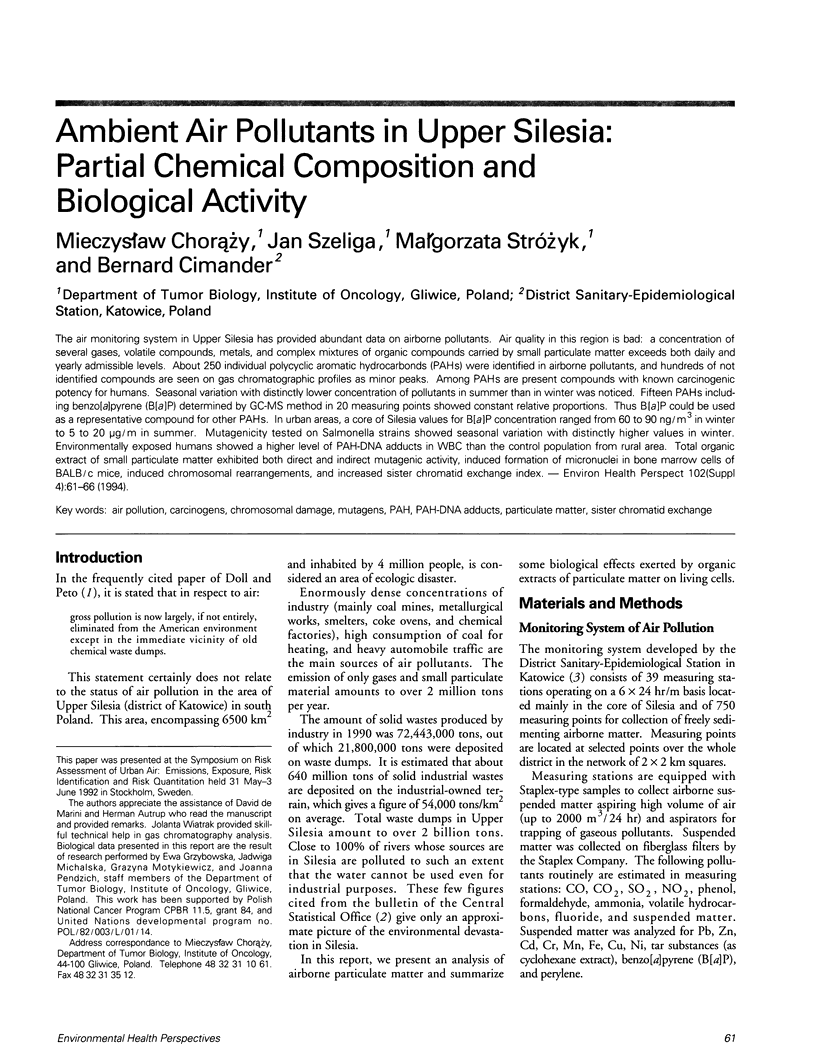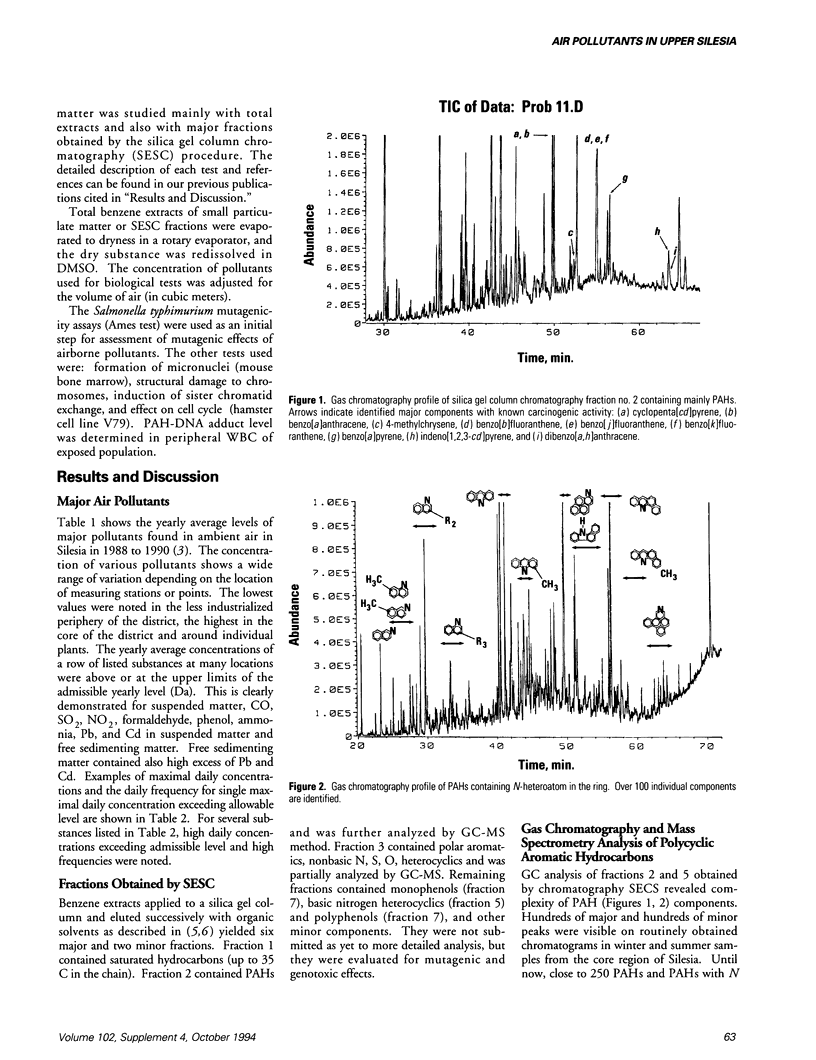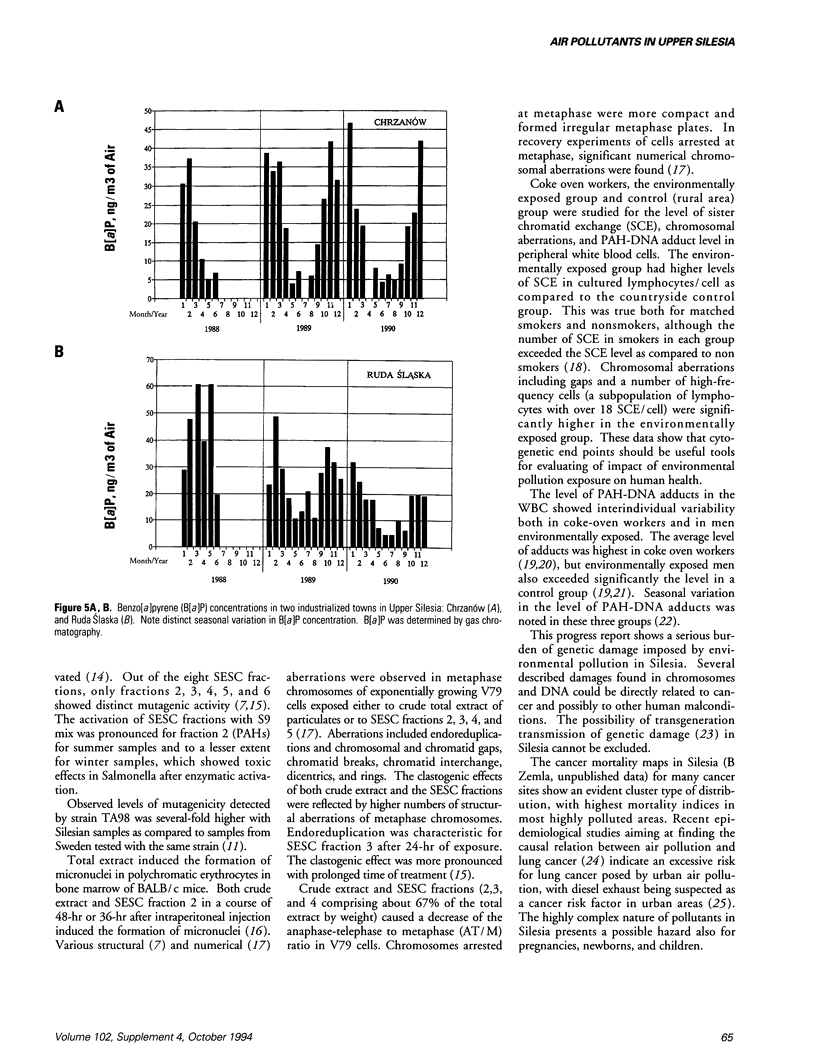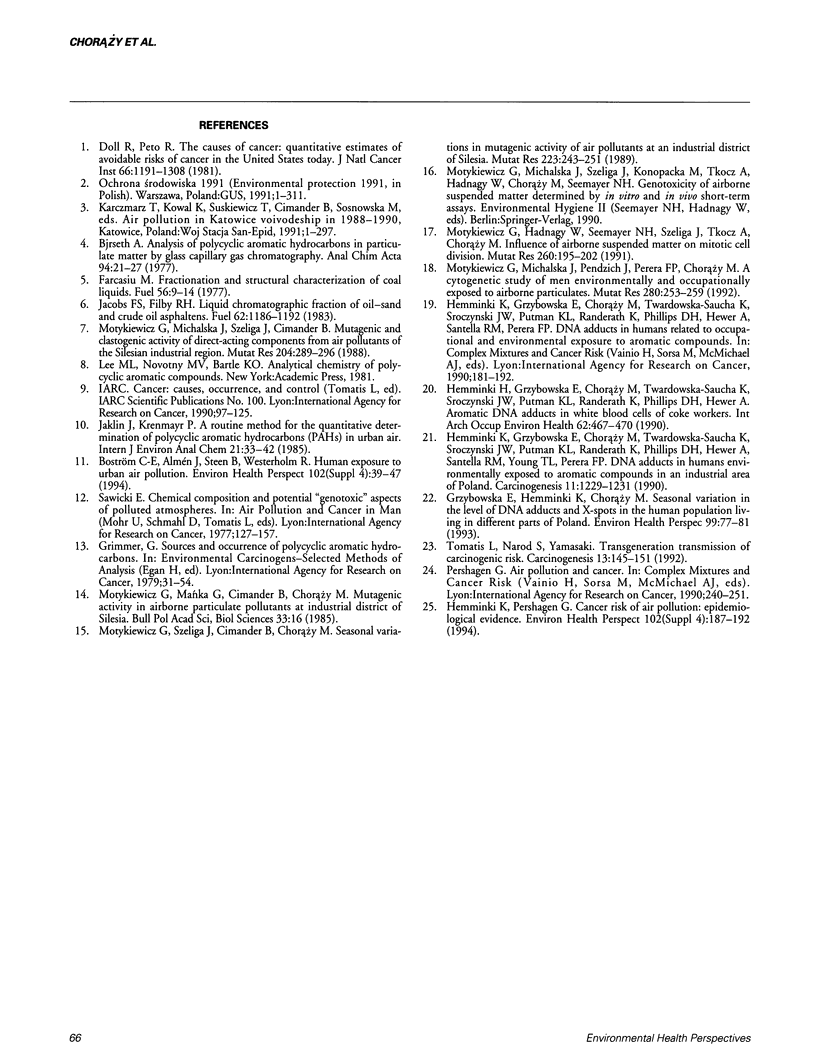Abstract
The air monitoring system in Upper Silesia has provided abundant data on airborne pollutants. Air quality in this region is bad: a concentration of several gases, volatile compounds, metals, and complex mixtures of organic compounds carried by small particulate matter exceeds both daily and yearly admissible levels. About 250 individual polycyclic aromatic hydrocarbonds (PAHs) were identified in airborne pollutants, and hundreds of not identified compounds are seen on gas chromatographic profiles as minor peaks. Among PAHs are present compounds with known carcinogenic potency for humans. Seasonal variation with distinctly lower concentration of pollutants in summer than in winter was noticed. Fifteen PAHs including benzo[a]pyrene (B[a]P) determined by GC-MS method in 20 measuring points showed constant relative proportions. Thus B[a]P could be used as a representative compound for other PAHs. In urban areas, a core of Silesia values for B[a]P concentration ranged from 60 to 90 ng/m3 in winter to 5 to 20 micrograms/m in summer. Mutagenicity tested on Salmonella strains showed seasonal variation with distinctly higher values in winter. Environmentally exposed humans showed a higher level of PAH-DNA adducts in WBC than the control population from rural area. Total organic extract of small particulate matter exhibited both direct and indirect mutagenic activity, induced formation of micronuclei in bone marrow cells of BALB/c mice, induced chromosomal rearrangements, and increased sister chromatid exchange index.
Full text
PDF





Selected References
These references are in PubMed. This may not be the complete list of references from this article.
- Boström C. E., Almén J., Steen B., Westerholm R. Human exposure to urban air pollution. Environ Health Perspect. 1994 Oct;102 (Suppl 4):39–47. doi: 10.1289/ehp.102-1566930. [DOI] [PMC free article] [PubMed] [Google Scholar]
- Doll R., Peto R. The causes of cancer: quantitative estimates of avoidable risks of cancer in the United States today. J Natl Cancer Inst. 1981 Jun;66(6):1191–1308. [PubMed] [Google Scholar]
- Grzybowska E., Hemminki K., Choraźy M. Seasonal variations in levels of DNA adducts and X-spots in human populations living in different parts of Poland. Environ Health Perspect. 1993 Mar;99:77–81. doi: 10.1289/ehp.939977. [DOI] [PMC free article] [PubMed] [Google Scholar]
- Hemminki K., Grzybowska E., Chorazy M., Twardowska-Saucha K., Sroczynski J. W., Putman K. L., Randerath K., Phillips D. H., Hewer A. Aromatic DNA adducts in white blood cells of coke workers. Int Arch Occup Environ Health. 1990;62(6):467–470. doi: 10.1007/BF00379065. [DOI] [PubMed] [Google Scholar]
- Hemminki K., Grzybowska E., Chorazy M., Twardowska-Saucha K., Sroczynski J. W., Putman K. L., Randerath K., Phillips D. H., Hewer A., Santella R. M. DNA adducts in human environmentally exposed to aromatic compounds in an industrial area of Poland. Carcinogenesis. 1990 Jul;11(7):1229–1231. doi: 10.1093/carcin/11.7.1229. [DOI] [PubMed] [Google Scholar]
- Hemminki K., Pershagen G. Cancer risk of air pollution: epidemiological evidence. Environ Health Perspect. 1994 Oct;102 (Suppl 4):187–192. doi: 10.1289/ehp.94102s4187. [DOI] [PMC free article] [PubMed] [Google Scholar]
- Motykiewicz G., Hadnagy W., Seemayer N. H., Szeliga J., Tkocz A., Chorazy M. Influence of airborne suspended matter on mitotic cell division. Mutat Res. 1991 Jun;260(2):195–202. doi: 10.1016/0165-1218(91)90008-a. [DOI] [PubMed] [Google Scholar]
- Motykiewicz G., Michalska J., Pendzich J., Perera F. P., Chorazy M. A cytogenetic study of men environmentally and occupationally exposed to airborne pollutants. Mutat Res. 1992 Oct;280(4):253–259. doi: 10.1016/0165-1218(92)90055-5. [DOI] [PubMed] [Google Scholar]
- Motykiewicz G., Michalska J., Szeliga J., Cimander B. Mutagenic and clastogenic activity of direct-acting components from air pollutants of the Silesian industrial region. Mutat Res. 1988 Feb;204(2):289–296. doi: 10.1016/0165-1218(88)90102-4. [DOI] [PubMed] [Google Scholar]
- Motykiewicz G., Szeliga J., Cimander B., Choraźy M. Seasonal variations in mutagenic activity of air pollutants at an industrial district of Silesia. Mutat Res. 1989 Jun;223(2):243–251. doi: 10.1016/0165-1218(89)90052-9. [DOI] [PubMed] [Google Scholar]
- Sawicki E. Chemical composition and potential 'genotoxic' aspects of polluted atmospheres. IARC Sci Publ. 1977;(16):127–157. [PubMed] [Google Scholar]
- Tomatis L., Narod S., Yamasaki H. Transgeneration transmission of carcinogenic risk. Carcinogenesis. 1992 Feb;13(2):145–151. doi: 10.1093/carcin/13.2.145. [DOI] [PubMed] [Google Scholar]


